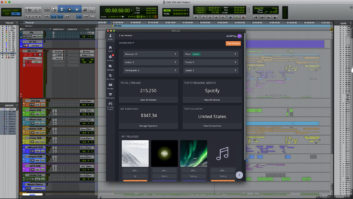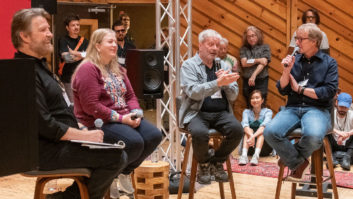Drum-recording techniques have undergone dramatic changes over the years, in part because of the options afforded by virtually unlimited track counts in modern DAWs. Long gone are the days of recording traps and cymbals to four tracks. In addition to using a stereo pair of overheads, most engineers like to mike each and every piece of the trap set with a separate mic to have the greatest control over levels at mixdown. But beyond that basic foundation, all bets are off. In the never-ending quest for new drum sounds, today’s leading engineers are combining adventurous miking and signal-processing techniques with the tried-and- true.
Mix interviewed three top-drawer engineers — David Bianco, Ed Seay and David Thoener — to discover their approaches to recording drums. (For a look at our interviewees’ credits, see “Bad Boys of Bang.”) These pros have a plethora of cool and often opposing recording techniques that they are happy to share. Yet, they all emphatically agreed that the key to slammin’ drum tracks starts with a great-sounding source.
GO TO THE SOURCE
“Truth be known,” Bianco says, “the key to the best drum sounds is great drums that are well-tuned and played by pros.” Thoener concurs. “The most important things in getting a great drum sound,” he says, “are tuning and technique. Tuning is absolutely the most important element. You can have a great drummer, but if the drums are not tuned properly, they’re not gonna sound good. You can take the same exact kit and have a person who does drum tuning for a profession come in and tune it, and you won’t believe it was the same kit [you started with]. It’s a combination of changing heads, [adjusting the] tension and tuning the bottom head against the top head.” He says that once that’s done properly, “the toms, especially, just ring out and sound amazing.”
Seay recalls the exact moment in his long career when he realized how critical it is for the source to sound great. He was assisting for engineer Cal Harris on a Commodores session in 1981 (recording the album In the Pocket for Motown) when he had “a real moment of clarity. Harris pushes up the kick drum mic’s fader,” Seay recalls, “and, wow, that sounds great right off the bat! And on the snare drum, damn! He barely touched the EQ! I thought, ‘No wonder these records sound so good. They’ve come in with great-sounding instruments. Duh!’ Even though I knew that the sound has to be great at the source, I didn’t know how bad the sources I’d been given [in the past] were until I heard professionals. I’d been working with a lot of road bands, live groups and rock groups with ragtag gear. Now, it’s like, ‘Boy, look at how much better my engineering just got today when all these good people came in,’” he says with a chuckle.
MANO A MONO
Each of the engineers interviewed for this article has a different approach to miking drums. Bianco shoots for a very cohesive effect, where the individual pieces of the kit don’t sound separate from one another. To achieve this effect, he always begins with “a mono microphone in front of the drum kit, placed where it will get the most complete picture of the drums: an equal amount of kick and snare, and just enough cymbals to where it’s not overdoing it. I add some cardioid mics on the left and right to that,” he says. “Then I fill it in with [separate mics on] the other drums.”
Bianco likes to place a kick drum mic “maybe four to six inches off the beater and pointed right at it.” He’ll often take the front head completely off of the kick, though he notes that it can sometimes impart flattering resonance if it’s left on and tuned a half-step higher than the pedal-side head.
Bianco often likes to experiment with using a second “crazy” mic on the kick drum. “Sometimes, I put an additional condenser microphone on the pedal side of the kick drum and squash the heck out of it with as inexpensive of a compressor as I can get,” he says with a laugh. “That gives you a really crazy, almost gated-reverb kind of sound. It adds size to the kick drum and serves as a snare undermic, as well. In fact, I’ve been using a pedal-side kick mic more often than an underneath snare mic. I’ll go in on the hi-hat side with a U87 and place the mic two inches off the beater-side head, pointed right at it. I’ll flip the mic’s phase and use a dbx 160x or something else on it. On its own, it sounds crazy, but mixed in, it gives the kick drum a lot more low-end punch. If you do it right, it almost sounds like there’s a lower octave to the kick drum. I find it sounds more effective than using an outside kick drum mic [on the front head]. For bands that are trying to be more like Beck or the Beastie Boys, it’s a wild-sounding drum sound on its own. But, I’ve also run it through a [Line 6] Pod or some kind of amplifier to get a great drum loop sound. It’s astounding.” To keep his options open at mixdown, Bianco prints the beater-side mic’s signal to a separate track.
Thoener takes a decidedly different approach to miking a kick drum. He typically aims at getting a natural sound, and one that has more low end than beater click. “I place an [AKG] D112 flush with the front head of the kick drum,” Thoener notes. “The mic would be touching the head if the hole wasn’t there. Then, I’ll mess with the angle to find the sweet spot.”
Thoener will often build a 2- to 3-foot-long tunnel in front of the kick drum by draping a heavy packing blanket over two flanking mic stands. “I’ll put a Neumann U47 inside the tunnel, about two feet back from the front head. I’ll adjust [the U47’s mic height to be somewhere] between the middle of the drum and the floor. That mic picks up a lot of bottom that you don’t get from the closer mic.” To get even more low end, Thoener will set up the drums on a riser whenever possible, thus isolating the kit from the damping effect of the studio’s floor.
Seay usually avoids miking the kick drum with two mics because of the phase cancellations that can result when the two signals are combined. When he does use two mics, he’ll align the two signals so that their waveform spikes line up in Pro Tools. But most of the time, he’ll simply place one mic just inside the hole in the kick’s front head and adjust the mic’s angle to get the sound he’s after. The Audio-Technica ATM25 and Neumann U47 FET are his favorite mics to record kick drum.
MY HI-HAT’S OFF TO YOU
When he’s putting a mic on the snare drum, Thoener always asks the drummer to “move his hi-hat as far over to his left as he possibly can and still play comfortably.” This allows Thoener to place a Shure SM57 on the snare drum so that the mic’s null point is directly facing the hi-hat. “I try to angle my snare mic underneath the hi-hat, but place it about two fingers’ [width] in height above the [perimeter] of the shell,” he explains. “That way, I’m gonna get some air off of the snare drum. I try to never choke on any of my mics. If you place the mics too close to the source, you get too much proximity effect.”
Thoener typically places two SM57s on snare, one on the top and the other on the bottom of the drum. He usually flips the phase of the bottom mic’s signal to align it with the top mic’s.
Thoener recalls the days when the total tracks available for recording drums were meager, usually forcing him to use only one mic on the top of the snare drum. To compensate at mixdown, he would re-excite the snares by feeding the pre-recorded snare track to an Auratone speaker aimed at the live drum. For isolation, both the speaker and snare drum would be placed out in the studio. Thoener would turn the snare drum upside down and suspend it off of the floor between stacks of books. Then, he would place the Auratone underneath the snare and on the floor so that it was facing up at the top head of the drum. Finally, he’d mike up the snares, which would rattle whenever the Auratone would voice the pre-recorded snare hits.
Of course, one man’s pleasure is another’s pain. Seay never mikes the bottom of the snare drum. “I’ve played with that,” he says, “and I just don’t love it. It never sounds like a big improvement to me. It’s not the way my ear hears the snare drum out in the room.”
GROUND CONTROL TO MAJOR TOMS
All three of these engineers generally prefer to record each tom with a separate mic placed on the top side of the drum only. In rare instances where Thoener feels he needs more bottom from a floor tom, he’ll also place a Sennheiser 421 on the bottom head of that drum. “I’ll start with a 421, and if that’s not working, I’ll switch to a U87,” Thoener says. He cautions that the bottom mic should be pointed in a way so that it rejects the sound of the other drums.
Seay very rarely mikes the bottom of toms. “But every now and then, I do,” he admits. “I think it provides a very neat perspective. It adds a depth and body to the sound that you can’t get any other way.”
As for topside tom mics, Thoener likes to use 421s with one exception: Where a drummer has a few “bongos,” or very small toms, in addition to the standard-sized rack toms, he’ll place a sole SM57 across all of the bongos.
Bianco also likes using 421s on toms. “I try to mike toms from as far away as I can,” he notes, “so I get as much ring [as possible] and not just attack. Usually, I end up with the mic five to seven inches away and pointed toward the center of the drum.”
A potential drawback to such a setup is that the tom mics may pick up excessive cymbal bleed. Bianco offers a creative solution for both cymbal and hi-hat bleed: “I’ll build a cardboard hood for snare and tom mics. “I’ll tape the hood to the microphone’s body or to the rim of the drum to make the mic reject the cymbals and hi-hat a little bit more.” If the cardboard causes any diffractive effects, he’ll put a bit of absorptive foam inside the hood, as well.
Miking up the cymbals themselves, Bianco likes to use AKG 414s, 452s or C12s. He will sometimes place a pair of 452s in an X-Y configuration, “just above where the drummer’s ears are,” and pointing toward the front of the kit. But he stresses the importance of optimizing the exact placement of the overhead mics in order to minimize phase cancellations. “If you use wide cardioids,” Bianco says, “you’ll find that your kick drum starts to disappear until you find the right spot for the mics.” Just moving the overhead mics a few inches can make a big difference in the sound.
Thoener avoids phase problems with overheads by spacing cardioid-mode AKG 414ULS mics above the far left and right sides of the kit, “on the outer edges of the cymbals.” Seay likes using AKG 414s, 451s or 452s, or Sanken cardioids in a spaced-pair or an X-Y configuration for overheads.
ROOM TO GROW
Room mics make a huge contribution to achieving a big drum sound. “I think the room mic is just as important as any other element [of the mic setup],” Seay says. “Even if the room mics are pulled in really tight in a really dead room, the sound is more pleasing and accurate to my ear than without [using them]. For more bombast or more rock, you can pull them back [farther away from the kit].”
Seay sometimes ends up using the tracking room’s talkback mic as an extra room mic, in addition to using two room mics placed in a spaced pair or an X-Y configuration. He cautions that when using a widely spaced pair of mics, one should make sure that one isn’t picking up a lot more snare than the other; otherwise, it can throw off the stereo image of the overall sound.
If he wants to capture more bottom-end guts from the drums, Seay will place his room mics “almost on the floor, so that the reflections are negated, and looking up at the kit. That’s a good way to avoid all of the cymbal bleed. It ‘plays up’ the bottom of the kit.
“Almost anything will work for room mics,” Seay continues, “as long as the mic is decent. [AKG] 414s or [Audio-Technica] 4033s do well. Sometimes, SM57s are perfect if you’re really going for crack and raw harshness.”
Thoener always records room mics in case he can use them in the mix, although they don’t always end up being useful. He likes using a stereo AKG C24 or Royer or Coles mics for “rooms,” placed roughly 15 feet away from the kit — as long as there are no other instruments in the room besides drums that could bleed into those mics. “I’ll usually keep the mics up fairly high,” he notes. “I really don’t want my room mics to pick up too much kick drum. If I’ve got an uptempo song or 60 faders on the mix, I really don’t want my kick drum getting too ambient because it’s just going to get lost in the mix. A lot of times, I find myself rolling off the bottom on those room mics so that I can work them into the mix without them taking presence away from the drums. Sometimes, if I like what they do for the snare but not for the other elements of the kit, I’ll gate the room mics and key them with the snare [mic’s signal].
“Instead of using room mics,” Thoener continues, “sometimes I’ll put one [Telefunken] 251 about three or four feet above the drummer’s head height, placed dead center right over the snare drum. Sometimes, I compress that just a little bit. I find that adds a natural ambience to my snare drum that the overheads don’t get.”
Bianco is a fan of using multiple room mics — including some with extreme processing applied — when recording drums. “I always have some tracks that use heavily compressed microphones for the more crazy kit sounds,” he enthuses. “I’ll use a mono omni or a stereo pair that are distressed big time with an [Empirical Labs] Distressor compressor. A four-to-one ratio sounds the best to me, but I really crank the input. Omni mics, even if they’re close in, can give you that Led Zeppelin kind of sound. I’ll also use the Distressor’s Distortion 2 setting a lot of the time; you get a little more grind using that.”
PROCESS THIS
Thoener will also use a Distressor while tracking drums, but only to achieve a relatively mild effect. He’ll typically use it on the snare drum to elongate the decay. “I’ll do maybe 4 or 5 dB of compression at three-to-one [ratio],” Thoener explains, “using a slow attack and a fairly quick release. That gives me a little more ring on the drum.”
Seay typically only applies compression to the room mics during tracking. He’ll compress the kick drum, however, if the dynamics are a little erratic or if the drum “needs a little pop on the front end.”
Thoener, Seay and Bianco are not shy about applying EQ to drums when tracking, as long as they’ve taken mic choice and miking techniques as far as they can go. Seay is the most outspoken of the three on the subject, confessing that he always applies some EQ. “My philosophy is, ‘Make it sound as good as possible, as quickly as possible,’” Seay elaborates.
It’s totally valid to beef-up the drums by any means while tracking, as long as you’re absolutely certain that they need it. That said, Thoener makes a plea to up-and-coming engineers who are tracking cuts that other engineers will mix. “Please, please,” Thoener implores, “stop over-compressing drums to tape. Compression should be used as little as possible [when tracking]. You’d be surprised by how many tapes I get where the overheads and room mics are compressed 20-to-one.” Thoener acknowledges that a heavily compressed sound might be what the tracking engineer was shooting for, “but if you decide, all of a sudden, that sound is not working for you any longer [at mixdown],” he warns, “you can’t change it. There’s nothing you can do about it.”
Michael Cooper is a Mix contributing editor and owner of Michael Cooper Recording in beautiful Sisters, Ore.
BAD BOYS OF BANG
From Mudhoney (Tomorrow Hit Today, March To Fuzz) and Ozzy Osbourne (Ozzmosis) to John Hiatt and the Black Crowes (Sho’ Nuff), David Bianco‘s engineering and mixing credits span a wide range of musical styles. Bianco also often lends his skills as a multi-instrumentalist to the records he produces. It was Bianco who tracked Tom Petty’s Wildflowers (Warner Bros., 1994), which won a Grammy for Best Engineered Album.
Ed Seay has recorded, mixed and produced scores of hit records since the late ’70s. His early successes with pop artists Paul Davis (Paul Davis), Marie Osmond (All in Love) and Melissa Manchester (Essence of Melissa Manchester) were followed by hit records for country icons Martina McBride (Way That I Am), Highway 101 (Reunited), Ricky Skaggs (My Father’s Son) and Collin Raye (Walls Came Down), to name just a few. Upcoming projects include new albums for Travis Tritt and Blake Shelton.
David Thoener has tracked and/or mixed hit records for Matchbox Twenty (Mad Season), Wheatus (Wheatus), Aerosmith (Get a Grip), Phil Vassar (Phil Vassar), and many more. Thoener won two Grammys — Record of the Year and Album of the Year — for mixing the single “Smooth” by Santana, featuring Rob Thomas (Supernatural, Arista, 1999).
— Michael Cooper







